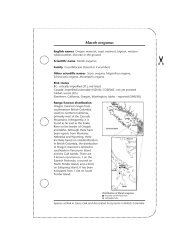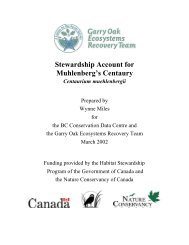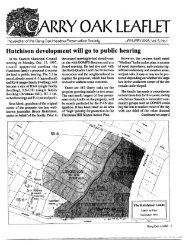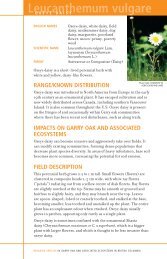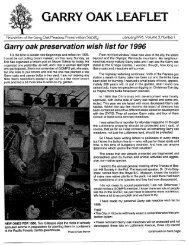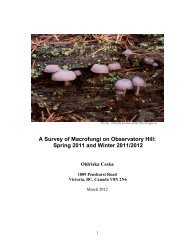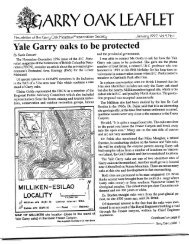- Page 1: Restoring British Columbia’s Garr
- Page 4 and 5: Published by the Garry Oak Ecosyste
- Page 6 and 7: Organizations Thanks to the followi
- Page 8 and 9: Christian Engelstoft, M.Sc., R.P.Bi
- Page 10 and 11: Dave Polster, M.Sc., R.P. Bio. Dave
- Page 13: Restoring British Columbia’s Garr
- Page 16 and 17: Chapter 1 Introduction 1-2 Restorin
- Page 18 and 19: Chapter 1 Introduction associated e
- Page 22 and 23: Chapter 1 Introduction without clea
- Page 24 and 25: Chapter 1 Introduction 1-10 Restori
- Page 26 and 27: Chapter 2 Distribution and Descript
- Page 28 and 29: Chapter 2 Distribution and Descript
- Page 30 and 31: Chapter 2 Distribution and Descript
- Page 32 and 33: Chapter 2 Distribution and Descript
- Page 34 and 35: Chapter 2 Distribution and Descript
- Page 36 and 37: Chapter 2 Distribution and Descript
- Page 38 and 39: Chapter 2 Distribution and Descript
- Page 40 and 41: Chapter 2 Distribution and Descript
- Page 42 and 43: Chapter 2 Distribution and Descript
- Page 44 and 45: Chapter 2 Distribution and Descript
- Page 46 and 47: Chapter 2 Distribution and Descript
- Page 48 and 49: Chapter 2 Distribution and Descript
- Page 50 and 51: Chapter 2 Distribution and Descript
- Page 52 and 53: Chapter 2 Distribution and Descript
- Page 54 and 55: Chapter 2 Distribution and Descript
- Page 56 and 57: Chapter 2 Distribution and Descript
- Page 58 and 59: Chapter 3 Natural Processes and Dis
- Page 60 and 61: Chapter 3 Natural Processes and Dis
- Page 62 and 63: Chapter 3 Natural Processes and Dis
- Page 64 and 65: Chapter 3 Natural Processes and Dis
- Page 66 and 67: Chapter 3 Natural Processes and Dis
- Page 68 and 69: Chapter 3 Natural Processes and Dis
- Page 70 and 71:
Chapter 3 Natural Processes and Dis
- Page 72 and 73:
Chapter 3 Natural Processes and Dis
- Page 74 and 75:
Chapter 3 Natural Processes and Dis
- Page 76 and 77:
Chapter 3 Natural Processes and Dis
- Page 78 and 79:
Chapter 3 Natural Processes and Dis
- Page 80 and 81:
Chapter 3 Natural Processes and Dis
- Page 82 and 83:
Chapter 3 Natural Processes and Dis
- Page 84 and 85:
Chapter 3 Natural Processes and Dis
- Page 86 and 87:
Chapter 3 Natural Processes and Dis
- Page 88 and 89:
Chapter 3 Natural Processes and Dis
- Page 90 and 91:
Chapter 3 Natural Processes and Dis
- Page 92 and 93:
Chapter 3 Natural Processes and Dis
- Page 94 and 95:
Chapter 3 Natural Processes and Dis
- Page 96 and 97:
Chapter 3 Natural Processes and Dis
- Page 98 and 99:
Chapter 4 Species and Ecosystems at
- Page 100 and 101:
Chapter 4 Species and Ecosystems at
- Page 102 and 103:
Chapter 4 Species and Ecosystems at
- Page 104 and 105:
Chapter 4 Species and Ecosystems at
- Page 106 and 107:
Chapter 4 Species and Ecosystems at
- Page 108 and 109:
Chapter 4 Species and Ecosystems at
- Page 110 and 111:
Chapter 4 Species and Ecosystems at
- Page 112 and 113:
Chapter 4 Species and Ecosystems at
- Page 114 and 115:
Chapter 4 Species and Ecosystems at
- Page 116 and 117:
Chapter 4 Species and Ecosystems at
- Page 118 and 119:
Chapter 4 Species and Ecosystems at
- Page 120 and 121:
Chapter 4 Species and Ecosystems at
- Page 122 and 123:
Chapter 4 Species and Ecosystems at
- Page 124 and 125:
Chapter 4 Species and Ecosystems at
- Page 126 and 127:
Chapter 4 Species and Ecosystems at
- Page 128 and 129:
Chapter 4 Species and Ecosystems at
- Page 130 and 131:
Chapter 4 Species and Ecosystems at
- Page 132 and 133:
Meadow-foam Macrae’s Clover Manro
- Page 134 and 135:
INVERTEBRATES (excluding butterflie
- Page 136 and 137:
Chapter 4 Species and Ecosystems at
- Page 138 and 139:
Marah oreganus Meconella oregana Ma
- Page 140 and 141:
INVERTEBRATES (excluding butterflie
- Page 142 and 143:
Propertius Duskywing Erynnis proper
- Page 144 and 145:
Small-headed Tarweed Hemizonella mi
- Page 146 and 147:
Howell’s Violet Viola howellii G4
- Page 148 and 149:
Nuttall’s Quillwort Isoetes nutta
- Page 150 and 151:
Chapter 4 Species and Ecosystems at
- Page 152 and 153:
Chapter 4 Species and Ecosystems at
- Page 154 and 155:
Chapter 4 Species and Ecosystems at
- Page 156 and 157:
Chapter 5 Restoration Planning 5.2.
- Page 158 and 159:
Chapter 5 Restoration Planning Gold
- Page 160 and 161:
Chapter 5 Restoration Planning Case
- Page 162 and 163:
Chapter 5 Restoration Planning Refe
- Page 164 and 165:
Chapter 5 Restoration Planning Stag
- Page 166 and 167:
Chapter 5 Restoration Planning Sett
- Page 168 and 169:
Chapter 5 Restoration Planning SMAR
- Page 170 and 171:
Chapter 5 Restoration Planning G vs
- Page 172 and 173:
Chapter 5 Restoration Planning Left
- Page 174 and 175:
Chapter 5 Restoration Planning 5.2.
- Page 176 and 177:
Chapter 5 Restoration Planning 5.2.
- Page 178 and 179:
Chapter 5 Restoration Planning prog
- Page 180 and 181:
Chapter 5 Restoration Planning The
- Page 182 and 183:
Chapter 5 Restoration Planning Park
- Page 185 and 186:
Approval signatures
- Page 187 and 188:
Table of contents 1.0 Restoration p
- Page 189 and 190:
Figures Figure 1. Map showing locat
- Page 191 and 192:
3.0 Site description 3.1 Overview A
- Page 193 and 194:
Figure 2. Plant community (site) ty
- Page 195 and 196:
3.4 Cultural features In July 2007,
- Page 197 and 198:
management prescriptions are summar
- Page 199 and 200:
Table 3. Objective 3 indicators and
- Page 201 and 202:
thickets will follow the protocol t
- Page 203 and 204:
Plugs and live stakes will be plant
- Page 205 and 206:
5.4.7. Forbs and grasses⎯general
- Page 207 and 208:
Public education will be achieved t
- Page 209 and 210:
Agronomic grasses⎯While eradicati
- Page 211 and 212:
9.0 References Blackwell, B.A. 2007
- Page 213 and 214:
Cooperative Extension. Available ht
- Page 215 and 216:
carinatus), and Kentucky bluegrass
- Page 217 and 218:
Table 6 cont’d Vegetation Type 1
- Page 219 and 220:
Table 7. Site type 74: Camas-Herbs
- Page 221 and 222:
Appendix 2⎯Exotic plant species o
- Page 223 and 224:
4. Use a rubber mallet to drive the
- Page 225 and 226:
Chapter 6 Outreach and Public Invol
- Page 227 and 228:
Chapter 6 Outreach and Public Invol
- Page 229 and 230:
Chapter 6 Outreach and Public Invol
- Page 231 and 232:
Chapter 6 Outreach and Public Invol
- Page 233 and 234:
Chapter 6 Outreach and Public Invol
- Page 235 and 236:
Chapter 6 Outreach and Public Invol
- Page 237 and 238:
Chapter 6 Outreach and Public Invol
- Page 239 and 240:
Chapter 6 Outreach and Public Invol
- Page 241 and 242:
Chapter 6 Outreach and Public Invol
- Page 243 and 244:
Chapter 6 Outreach and Public Invol
- Page 245 and 246:
Chapter 6 Outreach and Public Invol
- Page 247 and 248:
Chapter 6 Outreach and Public Invol
- Page 249 and 250:
Chapter 6 Outreach and Public Invol
- Page 251 and 252:
Chapter 6 Outreach and Public Invol
- Page 253 and 254:
Chapter 6 Outreach and Public Invol
- Page 255 and 256:
Chapter 6 Outreach and Public Invol
- Page 257 and 258:
Chapter 6 Outreach and Public Invol
- Page 259 and 260:
Chapter 6 Outreach and Public Invol
- Page 261 and 262:
Chapter 6 Outreach and Public Invol
- Page 263 and 264:
Chapter 6 Outreach and Public Invol
- Page 265 and 266:
Chapter 6 Outreach and Public Invol
- Page 267 and 268:
Chapter 6 Outreach and Public Invol
- Page 269 and 270:
Chapter 6 Outreach and Public Invol
- Page 271 and 272:
Chapter 6 Outreach and Public Invol
- Page 273 and 274:
Chapter 6 Outreach and Public Invol
- Page 275 and 276:
Chapter 6 Outreach and Public Invol
- Page 277 and 278:
Chapter 6 Outreach and Public Invol
- Page 279 and 280:
Chapter 6 Outreach and Public Invol
- Page 281 and 282:
Chapter 6 Outreach and Public Invol
- Page 283 and 284:
Chapter 6 Outreach and Public Invol
- Page 285 and 286:
Chapter 6 Outreach and Public Invol
- Page 287 and 288:
Chapter 6 Outreach and Public Invol
- Page 289 and 290:
Chapter 6 Outreach and Public Invol
- Page 291 and 292:
Chapter 6 Outreach and Public Invol
- Page 293 and 294:
Regional Parks T: 250.478.3344 490
- Page 295 and 296:
Regional Parks T: 250.478.3344 490
- Page 297 and 298:
The Corporation of the District of
- Page 299 and 300:
The Corporation of the District of
- Page 301 and 302:
Chapter 7 Ecological Inventory and
- Page 303 and 304:
Chapter 7 Ecological Inventory and
- Page 305 and 306:
Chapter 7 Ecological Inventory and
- Page 307 and 308:
Chapter 7 Ecological Inventory and
- Page 309 and 310:
Chapter 7 Ecological Inventory and
- Page 311 and 312:
Chapter 7 Ecological Inventory and
- Page 313 and 314:
Chapter 7 Ecological Inventory and
- Page 315 and 316:
Chapter 7 Ecological Inventory and
- Page 317 and 318:
Chapter 7 Ecological Inventory and
- Page 319 and 320:
Chapter 7 Ecological Inventory and
- Page 321 and 322:
Chapter 7 Ecological Inventory and
- Page 323 and 324:
Chapter 7 Ecological Inventory and
- Page 325 and 326:
Chapter 7 Ecological Inventory and
- Page 327 and 328:
Chapter 7 Ecological Inventory and
- Page 329 and 330:
Chapter 7 Ecological Inventory and
- Page 331 and 332:
Chapter 7 Ecological Inventory and
- Page 333 and 334:
Chapter 7 Ecological Inventory and
- Page 335 and 336:
Chapter 7 Ecological Inventory and
- Page 337 and 338:
Chapter 7 Ecological Inventory and
- Page 339 and 340:
Chapter 7 Ecological Inventory and
- Page 341 and 342:
Chapter 7 Ecological Inventory and
- Page 343 and 344:
Chapter 7 Ecological Inventory and
- Page 345 and 346:
Chapter 7 Ecological Inventory and
- Page 347 and 348:
Chapter 7 Ecological Inventory and
- Page 349 and 350:
Chapter 7 Ecological Inventory and
- Page 351 and 352:
Chapter 8 Restoration Strategies Re
- Page 353 and 354:
Chapter 8 Restoration Strategies Ch
- Page 355 and 356:
Chapter 8 Restoration Strategies th
- Page 357 and 358:
Chapter 8 Restoration Strategies st
- Page 359 and 360:
Chapter 8 Restoration Strategies Bl
- Page 361 and 362:
Chapter 8 Restoration Strategies Na
- Page 363 and 364:
Chapter 8 Restoration Strategies Ca
- Page 365 and 366:
Chapter 8 Restoration Strategies Do
- Page 367 and 368:
Chapter 8 Restoration Strategies sp
- Page 369 and 370:
Chapter 8 Restoration Strategies in
- Page 371 and 372:
Chapter 8 Restoration Strategies sp
- Page 373 and 374:
Chapter 8 Restoration Strategies 8.
- Page 375 and 376:
Chapter 8 Restoration Strategies Re
- Page 377 and 378:
Chapter 8 Restoration Strategies 8.
- Page 379 and 380:
Chapter 8 Restoration Strategies Po
- Page 381 and 382:
Chapter 9 Alien Invasive Species Re
- Page 383 and 384:
Chapter 9 Alien Invasive Species Ch
- Page 385 and 386:
Chapter 9 Alien Invasive Species 9.
- Page 387 and 388:
Chapter 9 Alien Invasive Species st
- Page 389 and 390:
Chapter 9 Alien Invasive Species ra
- Page 391 and 392:
Chapter 9 Alien Invasive Species Ca
- Page 393 and 394:
Chapter 9 Alien Invasive Species Ev
- Page 395 and 396:
Chapter 9 Alien Invasive Species Al
- Page 397 and 398:
Chapter 9 Alien Invasive Species Ca
- Page 399 and 400:
Chapter 9 Alien Invasive Species Ma
- Page 401 and 402:
Chapter 9 Alien Invasive Species Li
- Page 403 and 404:
Chapter 9 Alien Invasive Species in
- Page 405 and 406:
Chapter 9 Alien Invasive Species re
- Page 407 and 408:
Chapter 9 Alien Invasive Species 9.
- Page 409 and 410:
Chapter 9 Alien Invasive Species 9.
- Page 411 and 412:
Chapter 9 Alien Invasive Species Mc
- Page 413 and 414:
Forbs Carpet Burweed (Soliva sessil
- Page 415 and 416:
Ribwort Plantain* (Plantago lanceol
- Page 417 and 418:
Chapter 9 Alien Invasive Species Ap
- Page 419 and 420:
Chapter 10 Species Propagation and
- Page 421 and 422:
Chapter 10 Species Propagation and
- Page 423 and 424:
Chapter 10 Species Propagation and
- Page 425 and 426:
Chapter 10 Species Propagation and
- Page 427 and 428:
Chapter 10 Species Propagation and
- Page 429 and 430:
Chapter 10 Species Propagation and
- Page 431 and 432:
Chapter 10 Species Propagation and
- Page 433 and 434:
Chapter 10 Species Propagation and
- Page 435 and 436:
Chapter 10 Species Propagation and
- Page 437 and 438:
Chapter 10 Species Propagation and
- Page 439 and 440:
Chapter 10 Species Propagation and
- Page 441 and 442:
Chapter 10 Species Propagation and
- Page 443 and 444:
Chapter 10 Species Propagation and
- Page 445 and 446:
Chapter 10 Species Propagation and
- Page 447 and 448:
Chapter 10 Species Propagation and
- Page 449 and 450:
Chapter 10 Species Propagation and
- Page 451 and 452:
Chapter 10 Species Propagation and
- Page 453 and 454:
Chapter 10 Species Propagation and
- Page 455 and 456:
Chapter 10 Species Propagation and
- Page 457 and 458:
Chapter 10 Species Propagation and
- Page 459 and 460:
Chapter 10 Species Propagation and
- Page 461 and 462:
Chapter 10 Species Propagation and
- Page 463 and 464:
Chapter 10 Species Propagation and
- Page 465 and 466:
Chapter 10 Species Propagation and
- Page 467 and 468:
Chapter 10 Species Propagation and
- Page 469 and 470:
Chapter 10 Species Propagation and
- Page 471 and 472:
Chapter 10 Species Propagation and
- Page 473 and 474:
Chapter 10 Species Propagation and
- Page 475 and 476:
Chapter 10 Species Propagation and
- Page 477 and 478:
Chapter 10 Species Propagation and
- Page 479 and 480:
Chapter 10 Species Propagation and
- Page 481 and 482:
Seedling Stage: Container: Chapter
- Page 483 and 484:
Himalayan Blackberry* Rubus armenia
- Page 485 and 486:
Large-flowered Blue-eyed Mary Colli
- Page 487 and 488:
Wild Strawberry Aster curtus) Fraga
- Page 489 and 490:
None None None None None None None
- Page 491 and 492:
Mammals Columbian Black-tailed Deer
- Page 493 and 494:
Chapter 11 Conclusion and Glossary
- Page 495 and 496:
Chapter 11 Conclusion and Glossary
- Page 497 and 498:
Chapter 11 Conclusion and Glossary
- Page 499 and 500:
Chapter 11 Conclusion and Glossary
- Page 501 and 502:
Chapter 11 Conclusion and Glossary
- Page 503 and 504:
Chapter 11 Conclusion and Glossary
- Page 505 and 506:
Chapter 11 Conclusion and Glossary
- Page 507 and 508:
Chapter 11 Conclusion and Glossary
- Page 509 and 510:
Chapter 11 Conclusion and Glossary
- Page 511 and 512:
Chapter 11 Conclusion and Glossary
- Page 513 and 514:
Chapter 11 Conclusion and Glossary
- Page 515 and 516:
Chapter 11 Conclusion and Glossary
- Page 517 and 518:
Chapter 11 Conclusion and Glossary
- Page 520:
Parks Canada Parcs Canada Environme




